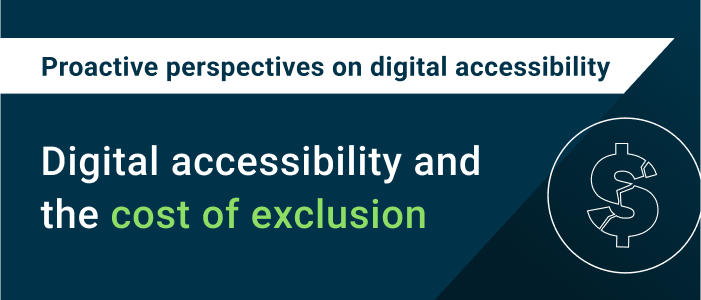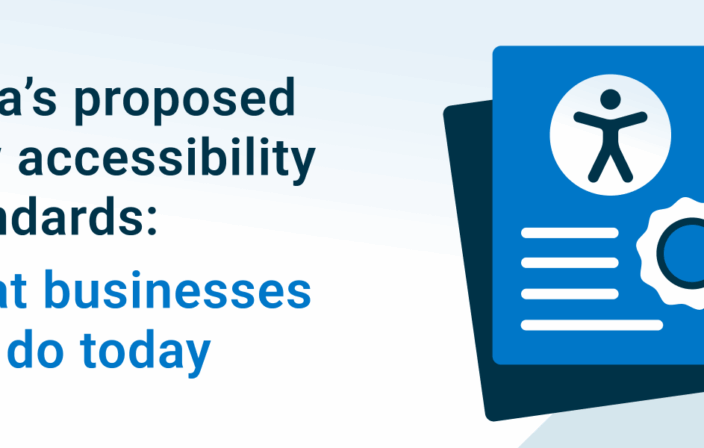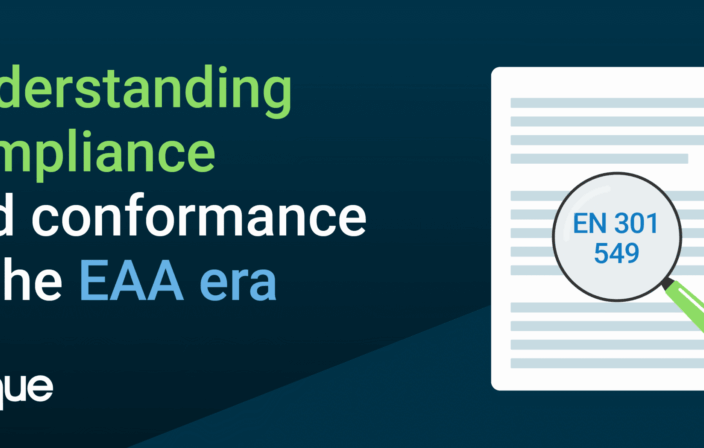In my previous Proactive Perspectives article, I explored lessons from the Accessibility for Ontarians with Disabilities Act (AODA), discussed what to do when digital accessibility goals remain elusive, and shared strategies for managing disruption and keeping your program on track.
Today, I want to build on those strategies by looking more closely at opportunities and challenges associated with digital accessibility—but with a twist. If you’ve read my articles in the past, you know I love to talk about the advantages of inclusion. Today, I’m going to turn that approach around and consider the disadvantages of exclusion.
No business wants to intentionally prevent customers or employees from having full access to its products and services, right? That would be counter-intuitive!
If you have something to offer, you want to make it available to as many people as possible. That’s how you succeed. But if your business skips or skimps on critical digital accessibility requirements, you exclude people from accessing your products and services. That limits your ability to succeed. In other words, exclusion will cost you.
My question today is, what is the impact of this exclusion, and how can we avoid it?
Fortunately, there are some very efficient and cost-effective solutions for mitigation, as well as emerging data that can help us understand the impact of exclusion.
Four pillars of digital accessibility value
To understand the cost of exclusion, let’s look at the four foundational pillars of digital accessibility value.
Pillar #1: Market share
As with any demographic, people with disabilities have desires, needs, and expectations that are specific to them. From a business standpoint, any given demographic represents an “addressable market.” In other words, they’re your potential customers.

Numbers will vary somewhat depending on the source data, but as an overall estimate, we understand the market size of people with disabilities to be in excess of 1 billion people, exceeding 15% of the overall worldwide population. The spending power of people with disabilities and their families is over 13 trillion dollars globally.
No business owner in their right mind would intentionally limit their access to these markets, right? And yet, organizations continue to rationalize reduced or no spending on digital accessibility practices that would guarantee access to a motivated market that wants to participate in products and services just the same as anyone else!
Doing the digital accessibility numbers
Calculating the exclusion impact here is fairly straightforward. If your business plan assumes that your product or service appeals to 50% of the various demographic market segments you’ve identified, and if you’ve skipped digital accessibility, you’ve just cut your potential sales by $250 billion in the United States and $4 trillion globally. Frankly, that’s a pretty monumental flaw in a business plan.
Cost of exclusion: Missing out on an addressable global market of more than 1 billion people with purchasing power in excess of 13 trillion dollars.
Pillar #2: Operational costs
A critical part of running any business is operations—determining how your business will manage designing, developing, manufacturing, marketing, distributing, and financially processing payments for your products and services. Depending on your anticipated margin, these decisions can be make-or-break situations at multiple points across your business lifecycle. Making intentional decisions to exclude people with disabilities from your operational considerations can have an immense—and immensely negative—impact on your success.
To provide an example of calculated impact, let’s consider a business that wants to implement a new and innovative way to take payments using Bitcoin. They’ve analyzed the impact of moving away from credit and debit cards with excessive funding fees to Bitcoin’s nearly fee-free transactions, and they estimate that customers willing to move to Bitcoin might represent 30% of 1 million monthly payments, with an average per transaction cost reduction of $8 each. Their anticipated result is savings of $28.8M per year in transaction costs. All good so far, right?
Doing the digital accessibility numbers
Let’s say the business decides to eliminate digital accessibility requirements because it will save them $250k in operating costs. While this might seem like significant savings, a closer look reveals a different picture. This decision will actually reduce savings by 15% to 20% because they’ve excluded the community of people with disabilities from the Bitcoin option. At 20%, the company will give up $5.7M in yearly sales—to avoid a $250,000 project cost? Not such a good idea after all, is it? And yet, decisions like this are made every day in companies all over the world.

Cost of exclusion: Saving $250k in operational costs, only to lose nearly $6M in potential sales revenue.
Pillar #3: Risk management
Risk management has been touted as a prime driver for digital accessibility for a couple of decades now, so I probably don’t need to say too much about this pillar. However, there is one thing I do want to address, which is the following (untrue) statement:
“I settled my accessibility lawsuit for $15,000, so why invest more than that in lawsuit avoidance?”
There are so many things wrong with this! And yet, I continue to hear variations of this from those taking a short view who don’t understand the true impact of their decisions.
Studies that I’ve done of Fortune 500 litigation here in the United States have shown that the average cost of getting to even a relatively small settlement can exceed $350,000—and that’s per instance! Lawsuits and litigation are some of the most highly disrupting situations that any company can face, and they demand the type of careful handling and focus that involves dozens of people, many important (and expensive) decision-makers, and, yes, a good amount of lawyers as well. When you tally all of the activities of all of these participants—their hourly costs, the retainers of the legal teams involved, and more—the expenses quickly add up to an exponential increase in costs.
Rather than pay for one lawsuit a year at $350,000 (in never-to-be-recouped dollars), you could instead fund your digital accessibility program to:
- Provide general awareness and role-based training to 5,000 employees.
- Fully equip 30+ content development teams with automation over the entire lifecycle.
- Professionally assess and remediate thousands of PDFs and other documents.
- Obtain a custom strategic playbook and transformation index.
- Hire a program manager to execute your program.
We’ve seen organizations get repeat lawsuits—sometimes even two or even three in a single year. Just think about what could be done with all the money! Remember, investment versus waste is an excellent business strategy.
Cost of exclusion: Hundreds of thousands of non-recoupable dollars lost to lawsuits that could be invested in cost-saving digital accessibility programs.
Pillar #4: Respect for basic human values
Last but certainly not least, we have the best case for flipping exclusion to inclusion: doing the right thing.
For many years, I’ve focused on quantifying the impacts of exclusion, or what we might call “the ROI of digital accessibility.” One concern I run into is people wondering if this equates to profiting off of the disability community. Let me be very clear: it does not. Nothing could be further from the truth. We’re not talking about profiting off of a community. We’re talking about ensuring that no one is excluded from accessing the products and services you’re providing to the world, and doing so in a way that is financially and operationally viable for your business.
The good news is that doing the right thing and respecting basic human values actually makes good business sense. And that’s a particularly good thing at a time when respect for basic human values is taking a big hit.
In an ideal world, businesses and customers have a mutually beneficial relationship. Businesses want to deliver desirable products and services to customers in a financially sustainable way, and customers want to improve their lives by purchasing those products and services in a financially sustainable way.
This is what the ROI of digital accessibility is all about. Investing in digital accessibility makes this mutually beneficial relationship possible. Your business can reach people with disabilities (which means more customers), and people with disabilities can access your products and services (which means more revenue).
Cost of exclusion: You’re doing the wrong thing ethically, and losing revenue doing it.
Exclusion doesn’t pay
I have dedicated my professional life to the mission of digital accessibility. And I am so fortunate. Every day, I work with businesses that are driven to succeed financially and that are also committed to making their digital properties and experiences available—for all the reasons I discussed above. Together, we’re making exclusion a relic of the past.
If there’s one thing I’ve learned, it’s that there’s a very strong (and very straightforward!) business case for embracing digital accessibility. By making your products and services accessible to everyone, you grow your customer base, save on operational costs, and limit legal risk—all while doing the right thing ethically.




